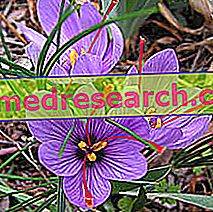Generality
Astaxanthin is a red-orange pigment, a member of the carotenoid macro-family.
Synthesized in appropriate quantities by microalgae - including Haematococcus pluvialis - Astaxanthin enters the food chain both through crustaceans and through predatory fish such as salmon, in which meat can easily reach 5-10 mg / kg.

Astaxanthin: Chemical Structure
The Astaxanthin, in light of its antioxidant properties, has acquired great importance in the last period in the prevention and management of different morbid states.
For this reason, Astaxanthin supplements have become widespread on the market, capable of facilitating their intake without the use of large quantities of fatty fish.

Photo: the shrimp owe their red carapace to Astaxanthin
Indications
Why is Astaxanthin used? What is it for?
The scientific literature attributes to Astaxanthin antioxidant, anti-inflammatory, cardioprotective, neuroprotective, gastroprotective, nephroprotective, antidiabetic, anti-cancer, anti-asthmatic and immunoprotective activities.
For these reasons, Astaxanthin is currently used in the prevention and control of many pathological states on low oxidative and inflammatory conditions.
Property and Effectiveness
What benefit has Astaxanthin shown during the studies?
The number of studies concerning the clinical and preventive efficacy of astaxanthin has increased exponentially in recent years.
The important amount of published works has therefore allowed us to characterize the biological potential of this molecule, highlighting its various utilities.
Cardio- and vaso-protective activity of astaxanthin
Several studies, both experimental and clinical, have shown and characterized the vaso-and cardio-protective effect of Astaxatin.
More precisely, the use of this molecule would have resulted in a reduction in the oxidation of LDL lipoproteins (main protagonists of vascular damage), while ensuring an increase in HDL blood concentrations.
Furthermore, the use of Astaxanthin would have reduced the size of the infarct area, in animal models of ischemia / reperfusion injury, thus highlighting direct cardioprotective activity.
Upon completion of this activity there would also be possible antihypertensive activities, probably related to a direct action of Astaxanthin on the renin-angiotensin system.
Antioxidant and photoprotective activity of Astaxanthin
Astaxanthin is the main antioxidant defense system of the Haeamatoccus pluvialis microalga, continuously exposed to UV radiation.
In the wake of its biological activity, different researchers have tried to characterize the antioxidant role of Astaxanthin.
The work showed its strong ability to inhibit peroxidation of membrane lipids, proteins and even nucleic acids, sustained by oxygen free radicals and ultraviolet radiation.
These activities would translate into the cytoprotective action of astaxanthin, particularly evident against photosensitivity damage such as erythema, papules, vesicles and burns.
Antioxidant and ophthalmoprotective activity of Astaxanthin
By virtue of what has just been described, Astaxanthin has proved to be particularly effective in preventing some oxidative pathologies of the eye, such as cataracts.
The antioxidant activity, however, would also be carried out against the retina and retinal vessels, safeguarding the correct trophism of these tissues and the entire functionality of this organ.
Anti-inflammatory activity of Astaxanthin
According to recent evidence, the administration of Astaxanthin could help to turn off the expression of genes, such as NF-Kb, involved in the activation of inflammatory processes.
This activity, associated with the simultaneous reduction of inflammatory cytokines, adhesion molecules and elements of phlogosis, would have proved to be valuable during different morbid states.
The anti-inflammatory action, associated with the antioxidant action, would be the basis of the neuroprotective and nephroprotective action of Astaxanthin.
Astaxanthin and fertility
The use of Astaxanthin has proved particularly valuable also in the management of man's fertility problems.
According to various evidences, this active principle could:
- Reduce concentrations of free oxygen radicals in semen;
- Control the secretions of inflammatory factors associated with hypofertility;
- Improve sperm motility;
- Increase the number of successful fertilizations.
Astaxanthin and sport
Despite the recent introduction of Astaxanthin in sports, preliminary studies would once again reveal the antioxidant role of this molecule.
More precisely, Astaxanthin would seem to reduce concentrations of muscle markers of oxidative damage following intense training.
This activity would be valuable in reducing the risk of muscle-tendon injuries and facilitating post-workout recovery.
Doses and method of use
How to use Astaxanthin
Although unequivocal dosages of Astaxanthin have not yet been defined, currently the most used is 5 mg daily.
More generally, the range of 2-8 mg daily is certainly the most used in the various studies.
Side effects
Leaving aside the adverse reactions linked to hypersensitivity to the active ingredient, the use of Astaxanthin was generally safe and well tolerated.
Contraindications
When should Astaxanthin not be used?
The use of Astaxanthin is contraindicated in case of hypersensitivity to the active ingredient or to the foods from which it is extracted (fish and shellfish).
Pharmacological Interactions
Which drugs or foods can modify the effect of astaxanthin?
Concomitant use of cholestyramine, colestipol, mineral oils, orlistat, pectins and vitamin E may reduce the intestinal absorption of astaxanthin.
Conversely, the intake of Beta-Carotene, medium chain triglycerides and vegetable oils could increase the absorption of Astaxanthin.
Precautions for use
What do you need to know before taking Astaxanthin?
Note the source of extraction of astaxanthin, mostly represented by small crustaceans, the use of supplements based on this active ingredient should be avoided or carefully supervised by a doctor in case of hypersensitivity to crustaceans.
The same precautions should be taken by pregnant women and during the subsequent breastfeeding period.



